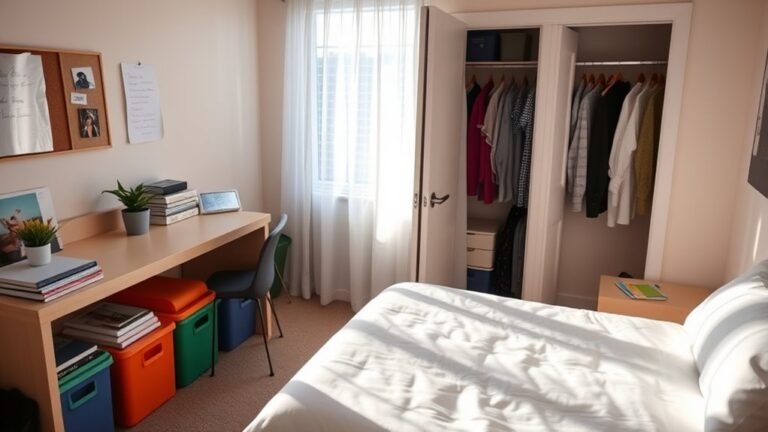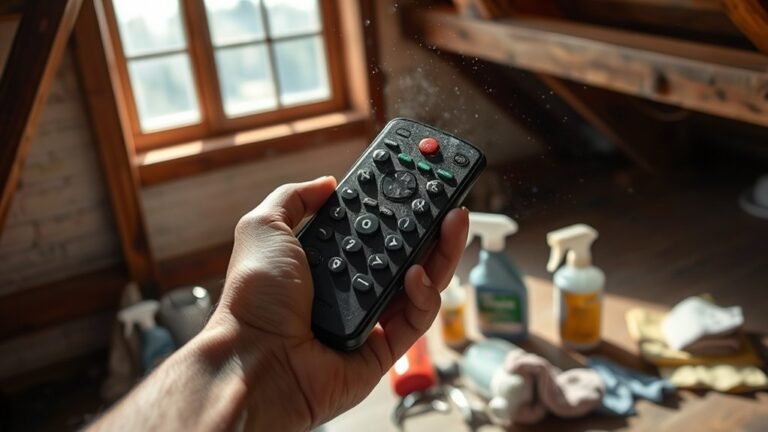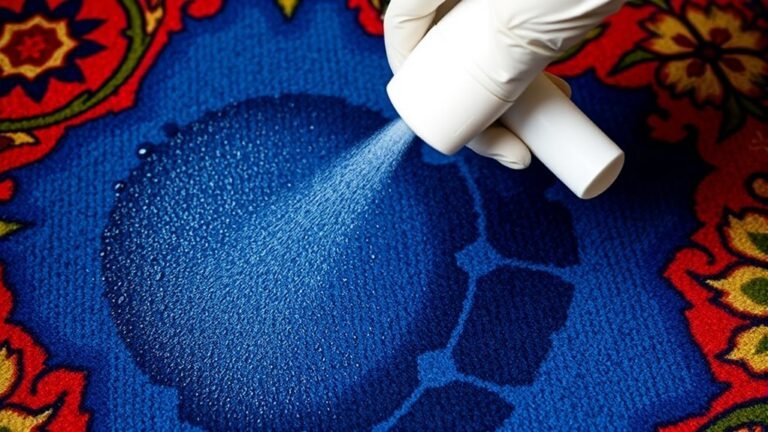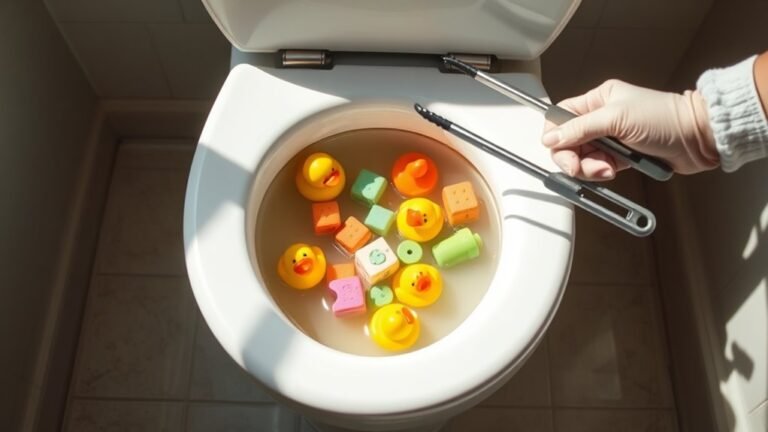How to Clean and Organize Your Home Library
To clean and organize your home library, start by evaluating your current collection and deciding which books to keep or donate. Gather cleaning supplies like a microfiber cloth and mild cleaner, then carefully dust your books and shelves. Next, sort your books by genre or personal preference and arrange them creatively on the shelves. Maintaining your library regularly prevents clutter and keeps it inviting. Keep going to discover easy tips to make your space truly shine.
Assess Your Current Book Collection

Before you start organizing, take a moment to assess your current book collection. This step is about understanding what you have and what truly sparks your freedom-loving spirit. Look through your shelves and group your books by genres that resonate with your personal preferences—whether it’s adventure, philosophy, or self-help. Don’t just sort; ask yourself which titles you actually want to keep and which no longer serve your journey. This honest evaluation helps you shed unnecessary clutter and makes room for the books that inspire and empower you. By focusing on what aligns with your interests, you’ll create a collection that feels intentional and liberating, setting the stage for a home library that reflects your true self.
Gather Cleaning Supplies and Tools
You’ll need a few essential cleaning supplies and tools to get your home library sparkling and organized. Start with a soft microfiber cloth to gently wipe dust without damaging your books or shelves. Grab a small vacuum or handheld duster to reach tight corners. For stubborn spots, a mild, non-toxic cleaner will work without harsh chemicals. Don’t forget organizational tools like bookends, shelf dividers, and storage bins to keep everything in its place once cleaned. Label makers or sticky notes can help you create a system that frees you from clutter and confusion. Having these cleaning supplies and organizational tools ready guarantees you’ll breeze through the process and reclaim your space with ease and freedom.
Remove Books and Dust Shelves

Start by carefully taking all the books off your shelves to create a clear workspace. This step frees you from clutter and lets you focus on the task. Next, use effective dust removal techniques like a microfiber cloth or a soft brush to wipe down every surface. Don’t forget to reach corners and edges where dust loves to hide. For stubborn spots, a slightly damp cloth works wonders. While cleaning, check your shelves for any signs of damage or wear. Applying shelf maintenance tips such as tightening screws or adding shelf liners can prolong their life and keep your library looking sharp. Taking this straightforward approach guarantees your shelves stay clean and ready to showcase your collection with pride and freedom.
Sort Books by Category or Genre
One of the most effective ways to organize your home library is by sorting books into categories or genres. This approach allows you to easily find what you want without feeling restricted by a rigid system. Start by grouping books according to your genre preferences—whether it’s mystery, science fiction, biographies, or self-help. Remember, your personal tastes should guide your organization, not conventional standards. Consider how category influences your reading habits and arrange books in a way that sparks joy and freedom. You might even create subcategories within genres to suit your lifestyle. By tailoring your library to your unique preferences, you turn your space into a sanctuary where every book invites exploration rather than obligation.
Decide Which Books to Keep or Donate

Now that your books are sorted, take a moment to assess their condition and decide which ones are worth keeping. Think about the personal value each book holds for you before making a choice. This will help you determine which titles to donate and which to keep on your shelves.
Assess Book Condition
Books tell stories beyond their pages, including their condition. When reviewing your collection, pay close attention to book preservation techniques you can apply to keep your favorites in top shape. Start by examining spine condition; a cracked or broken spine often means the book won’t hold up well on your shelves. Check for loose pages, stains, or mildew that could suggest permanent damage. If a book’s condition limits its usability or enjoyment, it might be time to let it go. Remember, organizing your library is about freedom—freeing space and energy for the books you truly treasure. By carefully evaluating each book’s physical state, you guarantee your home library stays both beautiful and functional, ready for many more stories to come.
Evaluate Personal Value
Although it can be tough to part with some titles, evaluating the personal value of each book helps you decide which ones to keep and which to donate. Start by reflecting on the personal significance a book holds for you—does it inspire, educate, or bring joy? Consider the sentimental value too; some books remind you of meaningful moments or people. If a book no longer serves you or feels like clutter, letting it go can free up space and mental energy. Remember, donating books can give them new life and help others. By honestly appraising what truly matters, you create a home library that reflects your current passions and frees you from unnecessary attachments. This thoughtful process empowers you to keep only what enriches your life.
Choose an Organizational System
Now that you’ve decided which books to keep, it’s time to pick an organizational system that works for you. You can sort by genre, author, or even color, depending on your preference. Don’t forget to label your shelves clearly to make finding and returning books easier.
Sorting Methods Overview
When organizing your home library, choosing the right sorting method can make all the difference in how easily you find and enjoy your collection. You want freedom to explore your books without frustration, so consider various sorting strategies that fit your lifestyle. Whether you prefer sorting by genre, author, or even color, inventory techniques like creating a simple list or using an app can help keep track. Some find alphabetical order liberating, while others enjoy grouping books by topic or mood. The key is picking a system that feels natural to you, making your library a place of ease and inspiration. Remember, your sorting method should serve you—not restrict you—so choose what brings you joy and flexibility.
Labeling and Categorizing
Since a well-chosen organizational system makes your library easier to navigate, labeling and categorizing your books is essential. You want to create a setup that feels natural and freeing, not restrictive. Start by exploring labeling techniques that suit your style—color-coded stickers, handwritten tags, or minimalist labels can all work, depending on your vibe. For categorizing strategies, think beyond traditional genres; group by mood, author, or even format to reflect how you actually search for books. Keep labels simple and consistent to avoid confusion and maintain freedom to rearrange as your collection evolves. Ultimately, your system should empower you to find any book quickly without feeling boxed in. This balance between order and flexibility makes your home library a true personal haven.
Arrange Books on Shelves Creatively
A well-arranged bookshelf can turn your home library into a visual delight. Don’t just stack books; play with color coordination and thematic displays to express your unique style. Mix genres or line up spines by color to create bold statements. You’re free to break traditional rules—arrange books vertically and horizontally for texture and interest.
| Creative Idea | Effect |
|---|---|
| Color coordination | Vibrant, eye-catching |
| Thematic displays | Storytelling, engaging |
| Mixed orientations | Dynamic, textured |
Let your shelves reflect your personality and passions. This creative approach invites you to enjoy every glance at your collection, making your library a true personal sanctuary.
Maintain Your Library Regularly
Once you’ve crafted a visually appealing and personalized bookshelf, keeping it tidy is key to preserving that charm. To enjoy your sanctuary freely, incorporate simple library maintenance tips into your routine. Set aside time each week for routine cleaning—dust shelves, wipe covers, and reorganize any stray books. This prevents clutter from creeping in and keeps your space inviting. Don’t wait for chaos to build; regular upkeep is your best ally. Use this time to assess your collection, removing books you no longer cherish to make room for new adventures. By embracing these habits, you maintain not just order but the freedom to explore your library without distraction. Your home library should be a place of calm, and routine cleaning guarantees it stays that way.
Frequently Asked Questions
How Do I Protect Rare Books From Damage?
To protect your rare books from damage, focus on book preservation by keeping them in a stable environment. You’ll want to maintain proper climate control—avoid extreme temperatures and humidity, which can warp or mold pages. Store books upright, away from direct sunlight, and use acid-free covers or boxes. Handling them gently also helps you preserve their freedom to be enjoyed for years without deterioration.
What’S the Best Way to Handle Moldy Books?
Oh, you just love finding moldy books, right? Not quite. To handle them, you’ll want to isolate the infected volumes immediately—no sharing the love (or spores). Gently brush off mold outside, then air them in a dry, well-ventilated space to halt further growth. Mold prevention is key; keep humidity low and sunlight indirect. For serious cases, book restoration pros can save your treasures, giving your freedom to enjoy books mold-free.
Can I Use Technology to Catalog My Books?
Absolutely, you can use technology for digital cataloging to simplify book management. With apps and software designed for this, you’re free to quickly search, sort, and track your collection without flipping through shelves. This tech-savvy approach lets you spend more time enjoying your books and less time organizing them. It’s a smart way to gain control over your library while keeping things flexible and efficient.
How Do I Prevent Books From Attracting Pests?
Imagine waking up to find your beloved books damaged by tiny invaders. To keep that nightmare away, focus on smart book storage—avoid damp, dark places where pests thrive. Keep your shelves clean and well-ventilated; pests hate fresh air! Use natural pest control methods like cedar blocks or lavender sachets. You’ll protect your collection and enjoy the freedom of a pest-free sanctuary where your stories can live on beautifully.
What Lighting Is Ideal for a Home Library?
You’ll want to balance ambient lighting with task lighting to create the perfect vibe in your home library. Ambient lighting sets the overall mood, giving you freedom to relax and enjoy your space without harshness. Meanwhile, task lighting focuses on your reading areas, like adjustable lamps or LED lights, so you don’t strain your eyes. Combining both lets you control brightness and comfort, making your library inviting and functional.






